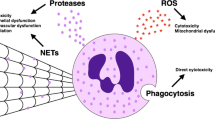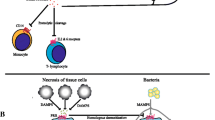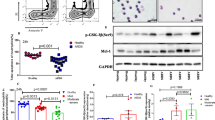Abstract
Neutrophils play a key role in the development of the systemic inflammatory response syndrome (SIRS) and multiple organ dysfunction syndrome (MODS). Since the lungs are the main target in these syndromes, with adult respiratory distress syndrome (ARDS) as the outcome, extensive research has been undertaken to prevent or mitigate ARDS. As evidence of the involvement of neutrophils in ARDS has accumulated, modulation of their function has become a major goal in terms of a therapeutic approach. In this short review, we sought to update our knowledge about neutrophils. Firstly, we summarized the various stimuli which activate neutrophils. Secondly, we described the different mediators, including cytokines, which are released by neutrophils. Lastly, we discussed the possible modulation of their function. Although we cannot assess the clinical usefulness of biochemical substances merely on the basis of their in vitro effects, understanding these mechanisms is fundamental to the success of the new therapeutic approach which is currently under way.
Similar content being viewed by others
References
ACCP/SCCM Consensus Conference Committee (1992) Definitions for sepsis and organ failure and guidelines for the use of innovative therapies in sepsis. Chest 101:1644–1655
Braude S, Apperley J, Krausz T, Goldman JM, Royston D (1985) Adult respiratory distress syndrome after allogenic bone-marrow transplantation: Evidence for a neutrophil-independent mechanism. Lancet, I:1239–1242
Ognibene FP, Martin SE, Parker MM, Schlesinger T, Roach P, Burch C, Shelhamer JH, Parrillo JE (1986) Adult respiratory distress syndrome in patients with severe neutropenia. N Engl J Med 315:547–551
Maunder RJ, Hackman RC, Riff E, Albert RK, Springmeyer SC (1986) Occurrence of the adult respiratory distress syndrome in neutropenic patients. Am Rev Respir Dis 133:313–316
Petty TL (1982) Adult respiratory distress syndrome: Definition and historical perspective. Clin Chest Med 3:3–7
Ishizaka A, Stephens K, Tazelaar HD, Hall EW, O'Hanley P, Raffin TA (1988) Pulmonary edema afterE. coli peritonitis correlates with thiobarbituric acid reactive materials in bronchoalveolar lavage fluid. Am Rev Respir Dis 137:783–789
Heflin AC, Brigham KL (1981) Prevention by granulocyte depletion of increased vascular permeability of sheep lung following endotoxemia. J Clin Invest 68:1253–1260
Okusawa S, Gelfand JA, Ikejima T, Connolly RJ, Dinarello CA (1988) Interleukin I induces a shock-like state in rabbits. J Clin Invest 81:1162–1172
Tracey KJ, Beutler B, Lowry SF, Merryweather J, Wolpe S, Milsark LW, Hariri RJ, Fahey III TJ, Zentella A, Albert JD, Shires GT, Cerami A (1986) Shock and tissue injury induced by recombinant human cachectin. Science 234:470–474
Stephens KE, Ishizaka A, Wu ZH, Larrick JW, Raffin TA (1988) Granulocyte depletion prevents TNF-mediated acute lung injury in guinea pigs. Am Rev Respir Dis 138:1300–1307
Matsushima K, Morishita K, Yoshimura T, Lavu S, Kobayashi Y, Lee W, Appella E, Kung HF, Leonard EJ, Oppenheim JJ (1988) Molecular cloning of a human monocyte-derived neutrophil chemotactic factor (MDNCF) and the induction of MDNCF mRNA by interleukin 1 and tumor necrosis factor. J Exp Med 167:1883–1893
Donnelly SC, Strieter RM, Kunkel SL, Walz A, Robertson CR, Carter DC, Grant IS, Pollok AJ, Haslett C (1993) Interleukin-8 and development of adult respiratory distress syndrome in at-risk patient groups. Lancet 341:643–647
Fujishima S, Sasaki J, Shinozawa Y, Takuma K, Hori S, Aikawa N (1993) Interleukin 8 in ARDS. Lancet 342:237–238
Hocking DC, Phillips PG, Ferro TJ, Johnson A (1990) Mechanisms of pulmonary edema induced by TNF. Circ Res 67:68–77
Ferrante A, Nandoskar M, Walz A, Goh DH, Kowanko IC (1988) Effects of tumor necrosis factor alpha and interleukin-1 alpha and beta on human neutrophil migration, respiratory burst and degranulation. Int Arch Allergy Appl Immunol 86:82–91
Dahinden C, Galanos C, Fehr J (1983) Granulocyte activation by endotoxin I. Correlation between adherence and other granulocyte functions, and role of endotoxin structure on biologic activity. J Immunol 130:857–862
Wright SD, Ramos RA, Tobias PS, Ulevitch RJ, Mathison JC (1990) CD14, a receptor for complexes of lipopolysaccharide (LPS) and LPS binding protein. Science 249:1431–1433
Webster RO, Hong SR, Johnston RB Jr, Henson PM (1980) The biological effects of the human complement fragments C5a and C5a desarg on neutrophil function. Immunopharmacology 2:201–219
Schiffman E, Corcoran BA, Wahl SA (1975) N-formylmethionyl peptides as chemoattractants for leukocytes. Proc Natl Acad Sci USA 72:1059–1062
Peveri P, Walz A, Dewald B, Baggiolini M (1988) A novel neutrophil-activating factor produced by human mononuclear phagocytes. J Exp Med 167:1547–1559
Gasson JC, Weisbart RH, Kaufman SE, Clark SC, Hewick RM, Wong GG (1984) Purified human granulocytemacrophage colony-stimulating factor: Direct action on neutrophils. Science 226:1339–1342
Ichinose Y, Hara N, Ohta M, Aso H, Chikama H, Kawasaki M, Kubota I, Shimizu T, Yagawa K (1990) Recombinant granulocyte colony-stimulating factor and liopolysaccharide maintain the phenotype of and superoxide anion generation by neutrophils. Infect Immun 58:1647–1652
Shalaby MR, Aggarwal, BB, Rinderknecht E, Svedersky LP, Finkle BS, Palladino MA Jr (1985) Activation of human polymorphonuclear neutrophil functions by interferon-γ and tumor necrosis factors. J Immunol 135:2069–2073
Ford-Hutchinson AW, Bray MA, Doing MV, Shipley ME, Smith JH (1980) Leukotriene B, a potent chemokinetic and aggregating substance released from polymorphonuclear leukocytes. Nature 286:264–265
Fiore S, Ryeom SW, Weller PF, Serhan CN (1992) Lipoxin recognition sites. J Biol Chem 267:16168–16176
Gay JC, Stitt ES (1988) Platelet-activating factor induces protein kinase activity in the particulate fraction of human neutrophils. Blood 71:159–165
Fällma M, Lew DP, Stendahl O, Andersson T (1989) Receptor-mediated phagocytosis in human neutrophils is associated with increased formation of inositol phosphates and diacylglycerol. J Clin Invest 84:886–891
Pardi R, Inverardi L, Bender JR (1992) Regulatory mechanisms in leukocyte adhesion: flexible receptors for sophisticated travelers. Immunol Today 13:224–229
Nathan C, Srimal S, Farber C, Sanchez E, Kabbash L, Asch A, Gailit J, Wright SD (1989) Cytokine-induced respiratory burst and CD11/CD18 integrins. J Cell Biol 109:1341–1349
Cluzel M, Undem BJ, Chilton FH (1989) Release of platelet-activating factor and the metabolism of leukotriene B4 by the human neutrophil when studied in a cell superfusion model. J Immunol 143:3659–3665
Prescott SM, Zimmerman GA, Seeger AR (1984) Leukotriene B4 is an incomplete agonist for the activation of human neutrophils. Biochem Biophys Res Commun 122:535–541
Henson PM (1981) Platelet activating factor (PAF) as a mediator of neutrophil-platelet interactions in inflammation. Agents Action 11:545–547
Bussolino F, Aglietta M, Sanavio F, Stacchini A, Lauri D, Camussi G (1985) Alkylether phosphoglycerides influence calcium fluxes into human endothelial cells. J Immunol 135:2748–2755
Janoff A, Scherer J (1968) Mediators of inflammation in leukocyte lysosomes. IX. Elastinolytic activity in granules of human polymorphonuclear leukocytes. J Exp Med 128:1137–1155
Gadek JE, Fells GA, Wright DG, Crystal RG (1980) Human neutrophil elastase functions as a type III collagen collagenase. Biochem Biophys Res Commun 95:1815–1822
Mainardi CL, Dixit SN, Kang AH (1980) Degradation of type IV (basement membrane) collagen by a proteinase isolated from human polymorphonuclear leukocyte granules. J Biol Chem 255:5435–5441
McDonald JA, Kelley DG (1980) Degradation of fibronectin by leukocytes elastase. Release of biologically active fragments. J Biol Chem 255:8848–8858
Macartney HW, Tschesche H (1983) Latent and active human polymorphonuclear leukocyte collagenases. Isolation, purification and characterization. Eur J Biochem 130:71–78
Dewald B, Bretz U, Baggiolini M (1982) Release of gelatinase from a novel secretory compartment of human neutrophils. J Clin Invest 70:518–525
Matzner Y, Barner M, Yahalom J, Ishai-Michaeli R, Fuks Z, Vlodavsky I (1985) Degradation of haparan sulfate in the subendothelial extracellular matrix by a readily released haparanase from human neutrophils. Possible role in invasion through basement membranes. J Clin Invest 76:1306–1313
Morishita K, Tsuchiya M, Asano S, Kaziro Y, Nagata S (1987) Chromosomal gene structure of human myeloperoxidase and regulation of its expression by granulocyte colony-stimulating factor. J Biol Chem 262:15208–15213
Tobias PS, Mathison JC, Ulevitch RJ (1988) A family of lipopolysaccharide binding proteins involved in responses to gram-negative sepsis. J Biol Chem 263:13479–13481
Jack RM, Fearon DT (1988) Selective synthesis of mRNA and proteins by human peripheral blood neutrophils. J Immunol 140:4286–4293
Fujishima S, Hoffman AR, Vu T, Kim KJ, Xheng H, Daniek D, Kim Y, Wallace EF, Larrick JW, Raffin TA (1993) The regulation of neutrophil interleukin 8 gene expression and protein secretion by LPS, TNF-α and IL-1β. J Cell Physiol 154:478–485
Kasama T, Strieter RM, Standiford TJ, Burdick MD, Kunkel SL (1993) Expression and regulation of human neutrophil-derived macrophage inflammatory protein 1α. J Exp Med 178:63–72
Lord PCW, Wilmoth LMG, Mizel SB, McCall CE (1991) Expression of interleukin-1α and β genes by human blood polymorphonuclear leukocytes. J Clin Invest 87:1312–1321
Lindemann A, Riedel D, Oster W, Meuer SC, Blohm D, Mertelsmann RH, Herrmann F (1988) Granulocyte/macrophage colony-stimulating factor induced interleukin 1 production by human polymorphonuclear neutrophils. J Immunol 140:837–839
Cicco NA, Lindemann A, Content J, Vandenbussche P, Lübbert M, Gauss J, Merteismann R, Hermann F (1990) Inducible production of interleukin-6 by human polymorphonuclear neutrophils. Role of granulocyte-macrophage colony-stimulating factor and tumor necrosis factor-alpha. Blood 75:2049–2052
Bazzoni F, Cassatella MA, Rossi F, Ceska M, Dewald B, Baggiolini M (1991) Phagocytosing neutrophils produce and release high amounts of the neutrophil-activating peptide 1/interleukin 8. J Exp Med 173:771–774
Dubravec DB, Spriggs DR, Mannick JA, Rodrick ML (1990) Circulating human peripheral blood granulocytes synthesize and secrete tumor necrosis factor α. Proc Natl Acad Sci USA 87:6758–6761
Djeu JY, Serbousek D, Blanchard DK (1990) Release of tumor necrosis factor by human polymorphonuclear leukocytes. Blood 76:1405–1409
Shirafuji N, Matsuda S, Ogura H, Tani K, Kodo H, Ozawa K, Nagata S, Asano S, Takaku F (1990) Granulocyte colonystimulating factor stimulates human mature neutrophilic granulocytes to produce interferon-α. Blood 75:17–19
Lindemann A, Riedel D, Oster W, Ziegler-Heitbrock HWL (1989) Granulocyte-macrophage colony-stimulating factor induces cytokine secretion by human polymorphonuclear leukocytes. J Clin Invest 83:1308–1312
Kita H, Ohnishi T, Okubo Y, Weiler D, Abrams JS, Gleich GJ (1991) Granulocyte/macrophage colony-stimulating factor and interleukin 3 release from human peripheral blood eosinophils and neutrophils. J Exp Med 174:745–748
Grotendorst GR, Smale G, Pencev D (1989) Production of transforming growth factor beta by human peripheral blood monocytes and neutrophils. J Cell Physiol 140:396–402
McColl SR, Paquin R, Ménard C, Beaulieu A (1992) Human neutrophils produce high levels of the interleukin 1 receptor antagonist in response to granulocyte/macrophage colony-stimulating factor and tumor necrosis factor α. J Exp Med 176:593–598
Fisher Jr CJ, Dhainaut JF, Pribble JP, Pharm D, Knaus WA, Thompson RC, the IL-1ra Phase III Sepsis Syndrome Study Group (1993) A phase III multicenter trial of human recombinant interleukin-1 receptor antagonist (IL-1rα) in the treatment of patients with sepsis syndrome. Lymphokine Cytokine Res 12:390
Dinarello CA, Gelfand JA, Wolff SM (1993) Anticytokine strategies in the treatment of the systemic inflammatory response syndrome. JAMA 269:1829–1835
Mohler KM, Torrance DS, Smith CA, Goodwin RG, Stremler KE, Fung VP, Madani H, Widmer MB (1993) Soluble tumor necrosis factor (TNF), receptors are effective therapeutic agents in lethal endotoxemia and function simultaneously as both TNF carriers and TNF antagonists. J Immunol 151:1548–1561
Moser B, Dewald B, Barella L, Schumacher C, Baggiolini M, Clark-Lewis I (1993) Interleukin-8 antagonists generated by N-terminal modification. J Biol Chem 268:7125–7128
Hinds CJ (1992) Monoclonal antibodies in sepsis and septic shock: recent progress, vast potential. BMJ 304:132–133
Rustici A, Velucchi M, Faggioni R, Sironi M, Ghezzi P, Quataert S, Green B, Porro M (1993) Molecular mapping and detoxification of the lipid A binding site by synthetic peptides. Science 259:361–365
Larrick JW, Hirata M, Zheng H, Bolin D, Cavaillon J, Warren HS, Wright SC (1994) A novel granulocyte-derived peptide with lipopolysaccharide-neutralizing activity. J Immunol 152:231–240
Said SI, Foda HD (1989) Pharmacologic modulation of lung injury. Am Rev Respir Dis 139:1553–1564
Watson SR, Fennie C, Lasky LA (1991) Neutrophil influx into an inflammatory site inhibited by a soluble homing receptor-IgG chimaera. Nature 349:164–167
Mulligan MS, Varani J, Dame MK, Lane CL, Smith CW, Anderson DC, Ward PA (1991) Role of endothelial-leukocyte adhesion molecule 1 (ELAM-1) in neutrophil-mediated lung injury in rats. J Clin Invest 88:1396–1406
Takenawa T, Ishitoya J, Nagai Y (1986) Inhibitory effect of prostaglandin E2, forskolin and dibutyryl cAMP on arachidonic acid release and inositol phospholipid metabolism in guinea pig neutrophils. J Biol Chem 261:1092–1098
Cronstein BN, Rosenstein ED, Kramer SB, Weissmann G, Hirschhorn R (1985) Adenosine; a physiologic modulator of superoxide anion generation by human neutrophils. Adenosine acts via an A2 receptor on human neutrophils. J Immunol 135:1366–1371
Fujishima S, Kraft SA, McGuire GP, Raffin TA, Pearl RG (1991) Isoproterenol prevents oxidant-induced injury in isolated rabbit lungs. Pharmacology 43:78–83
Parker RE, Hardin JR, Brigham KL (1988) Verapamil attenuates lung vascular responses to endotoxin in sheep. J Appl Physiol 65:2138–2143
Claman H (1992) Corticosteroids as immunomodulators: In: Georgiev V, Yamaguchi H (eds) Immunodulating drugs. Ann New York Acad Sci 685:288–292
Perretti M, Ahluwalia A, Harris JG, Goulding NJ, Flower RJ (1993) Lipocortin-1 fragments inhibit neutrophil accumulation and neutrophil-dependent edema in the mouse. J Immunol 151:4306–4314
Heffner JE, Repine JE (1989) Pulmonary strategies of antioxidant defense. Am Rev Respir Dis 140:531–554
Marzi I, Bühren V, Schüttler A, Trentz O (1993) Value of superoxide dismutase for prevention of multiple organ failure after multiple trauma. J Trauma 35:110–120
Zhu N, Liggitt D, Liu Y, Debs R (1993) Systemic gene expression after intravenous DNA delivery into adult mice. Science 261:209–211




